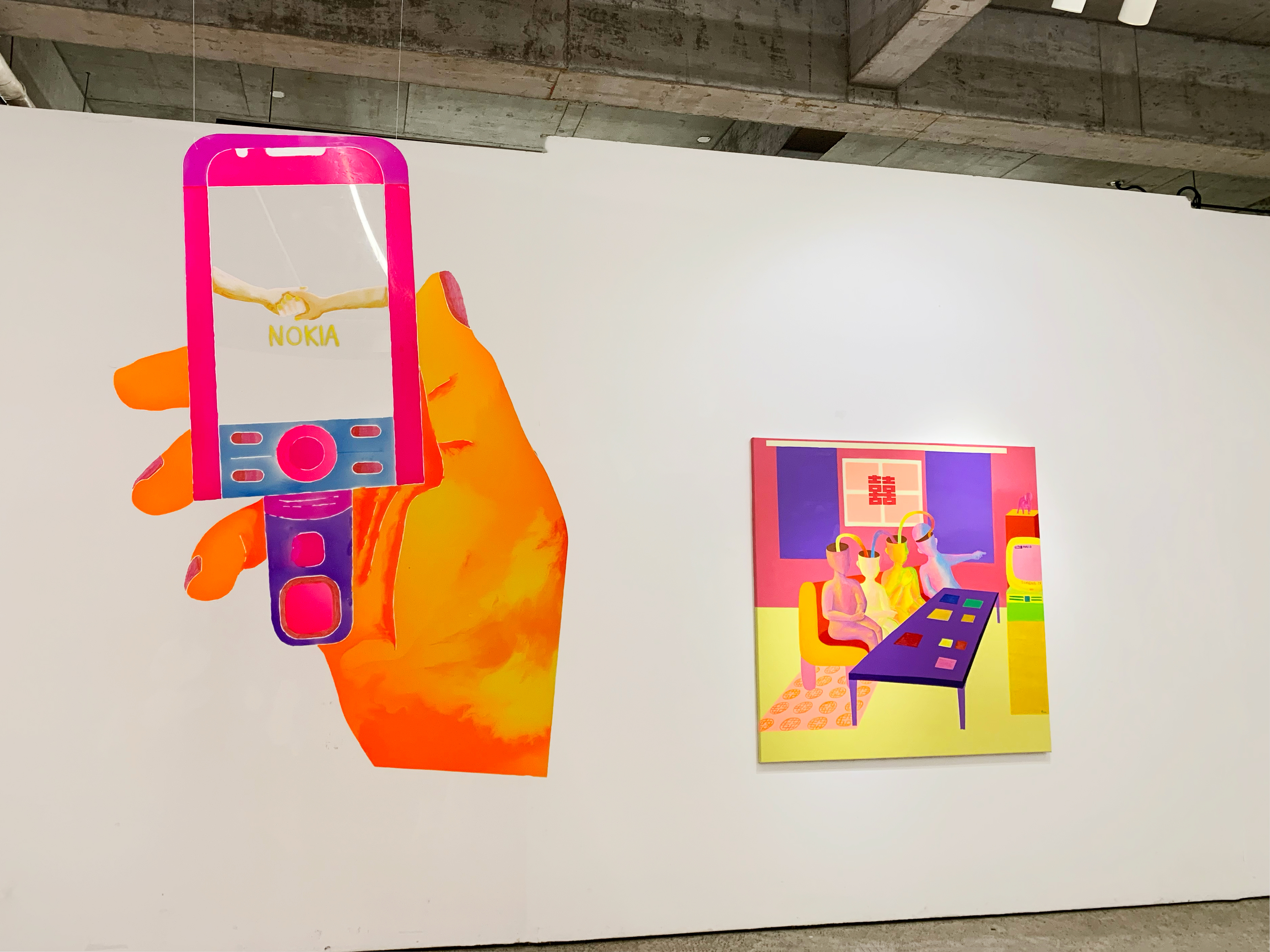
机械回环
Machinery in the Loop
文:温天
Written by: Tian Wen

韩博沅的近期作品援引了智能手机UI界面的平面设计风格,画面上明艳的色彩与扁平化的构图直指当代人的电子视觉经验,巨大化的便携设备形象又为其赋予了纪念碑式的宏伟。她持续关注技术滥用对人类生活境遇的影响,在其独特的Humanbot科幻叙事中,人类与机械之间有着相互转化乃至同义替换的关系。
Jennifer Boyuan Han's recent works draw from the flat design aesthetic of smartphone UIs, where the vibrant colors and flat compositions directly address contemporary electronic visual experiences. The magnified image of portable devices lends her art a sense of monumentality. Her focus remains consistent on the implications of technological overuse on human living conditions. Within her unique Humanbot sci-fi narrative, there is an interchangeability, even synonymity, between humans and machines.

这些怪异的形体在对人类身体进行陌生化的同时,也以其内在的关系网络形成一个混合了机械元素的生态循环圈。
These peculiar forms, while defamiliarizing the human body, also establish an ecological cycle interwoven with mechanical elements.

从图像上来说,Humanbot系列并不是陌生的奇观,它可以追溯至哈拉维的赛博格。基于其对生育的解放与传统社会结构的挑战,赛博格是女性主义的天然盟友,它为女性主义者们提供了以通信技术和生物技术重新编码自己身体的路径。
From an imagery perspective, the Humanbot series isn't a novel spectacle—it traces back to Donna Haraway's Cyborg. With its emancipation concerning reproduction and its challenge to traditional societal constructs, the Cyborg becomes a natural ally for feminism, offering feminists a pathway to recode their bodies through communication and biotechnologies.
尽管同样基于后人类主义视角,不同于哈拉维乐观地发表宣言的80年代,韩博沅基于21世纪的技术滥用状况更新了人类与机械结合的方式。在她的科幻想象中,女性保留了孕育生命的能力,以肉身融合异质,在接纳与妥协中诞下机械与人类的混合物种。那个由技术解放每个人的乌托邦并未到来,取而代之的是一种新的内在的技术统治与普遍的感官殖民。
While also rooted in a post-humanism perspective, Han diverges from the optimistic declarations of the 1980s by Haraway. Han, considering the 21st century's technological excesses, reimagines the fusion of humans and machines. In her sci-fi vision, women retain the ability to bear life, physically merging with the non-organic, giving birth to hybrid species amidst acceptance and compromise. The utopia where technology liberates everyone hasn't manifested; in its place emerges a novel form of inner technocracy and a pervasive sensory colonization.

客厅是家庭范围内最具有公共性的空间,韩博沅将客厅作为Humanbot活动的主要场景,昭示着信息技术对家庭亲缘关系的重构。尽管人物形象被抹消了个性特征,韩博沅描绘的客厅依然有着具体的身份标识,而非普遍的抽象的舞台布景——这是典型的当代中式客厅风景。在城市化与全球经济拓宽了肉身活动的空间尺度后,中式家庭常以极远的物理距离分隔,又以信息技术维持着极其牢固的亲密属性。
The living room, as the most public space within a home, serves as the primary setting for Humanbot activities in Han's works, highlighting the restructuring of familial ties by information technology. Although individual traits of the figures are obscured, the depicted living rooms bear distinct identity markers—typical of contemporary Chinese living room landscapes. In an age where urbanization and global economics expand the scale of physical movement, Chinese families are often physically distant yet maintain strong intimacy through technology.

作品中出现的手机型号往往具有时代代表性,同时也是曾经与她的身体生长在一起的,凝结了个人生命体验的物质实体。她忠实描摹的自画像如同镜子一般,倒映出所属身份群体的共同面孔。
The mobile phone models in her works often symbolize specific eras, and simultaneously, they represent objects that grew alongside her, material embodiments of personal life experiences. Her faithfully rendered self-portraits act like mirrors, reflecting the collective face of her identity group.

手机屏幕也是韩博沅创作中的典型元素,封闭的屏幕边框与孕育Humanbot的母胎空间互文,而屏幕内部的动态视野则暗示着人类与技术结合后的多重可能性。如同苏州园林的花窗,屏幕边框在将完整世界切割成碎片的同时,暗合了移步换景的东方美学。在去中心化的宇宙中,局部的片段信息有着不低于全景的价值。
Mobile screens are also emblematic in Han's oeuvre. The confines of the screen frame and the womb nurturing Humanbots display intertextuality, while the dynamic visuals within suggest multifaceted potentials after human-tech amalgamation. Much like the ornate windows in Suzhou gardens, screen frames fragment the complete world, subtly embracing the Eastern aesthetic of changing scenery with every step. In a decentralized universe, segmented local information holds comparable value to a panorama.
在Screen系列作品中,韩博沅巧妙地使用透明媒介还原了人类与电子屏幕最基础的关系,以去技术化的手段再现了技术时代隐在的社会结构。
In the Screen series, Han adeptly utilizes transparent mediums to depict the foundational relationship between humans and electronic screens, employing detechnicalization as a means of representation to reveal the hidden societal structures of the tech age.

这种媒介间的转译使得作品媒介本身的物质属性显得尤为重要。信息的交换基于物质的交换,人与机械的物质结合体正是对生物信息与数字信息结合的隐喻。在人与机械的相互转换中,当下社会已经早已把智能设备纳入全球资本主义经济循环的轨道中,物质与信息的湍流轮回往复,形成一个牢不可破的闭环。
This intermediality emphasizes the materiality of the art medium itself. Information exchange is predicated on material exchange; the physical union of humans and machines becomes a metaphor for the convergence of biological and digital information. In the transformation between humans and machines, contemporary society has already integrated smart devices into the orbits of global capitalist economies. The tumultuous cycle of material and information forms an unbreakable loop.